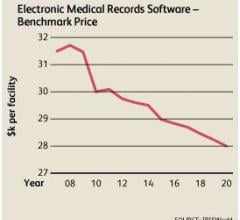
March 31, 2015 — The physician-patient relationship still plays a primary role in the overall patient experience despite increasing use of technology, according to a survey conducted by Nuance Communications Inc. The 3,000-person survey — conducted in the United States, United Kingdom and Germany — found that 97 percent of people agreed with this sentiment.
Nuance’s survey, “Healthcare from the Patient Perspective,” revealed the importance of physicians establishing a personal connection with patients through eye contact, a handshake, 1:1 conversation and privacy in the exam room. Technology is seen as an enhancement, and should play a supporting role.
According to a 2013 RAND Corporation study, physicians believe technology challenges are to blame for most of their frustrations: Forty-three percent felt electronic health records (EHRs) slow them down and 36 percent reported EHRs interfere with face-to-face care. However, in Nuance’s study, virtually all patients report they are comfortable with their physician using technology during a consultation and 58 percent believe this technology positively impacts their overall experience especially when used collaboratively to educate or explain.
“Physicians just don’t spend enough time with their patients nor do they look at their patients anymore. I hear that complaint from patients on a regular basis,” said Mark Michelman, M.D., MBA, vice president of medical affairs, BayCare Health System, Clearwater, Florida. "The electronic medical record and mandated regulatory documentation are requiring the physicians to spend much more time on the computer and allowing them less time to spend with their patients. This has a very negative effect on the patients who want the physician to spend more time with them and actually have eye contact with them, not with the computer.”
At the heart of the visit, patients agree on the top things physicians cannot ignore when it comes to quality medical care:
- 73 percent say “time for discussion;”
- 66 percent say “verbal communication of specific recommendations;”
- The third-most important factor varies by region
- Patients in Germany choose privacy in the exam room, while patients in the U.S. and UK value eye contact with physicians.
Using medical scribes to alleviate the time and documentation challenges of entering data in EHRs may come at a cost. In this survey, 95 percent of patients report they are completely honest with their physician today, but concerns over privacy topped the charts. Solutions that preserve the physician-patient relationship and enable providers to increase productivity while keeping their focus and eyes on the patient are likely to support a better patient experience.
“Patient engagement is more than just the buzzword of the moment – it’s a key to unlocking a healthier population and fixing some of the widening cracks of the healthcare system,” said Nick van Terheyden, M.D., CMIO, Nuance. “As this survey shows, the relationship between physicians and their patients is paramount in truly achieving engagement with patients in ways that matter most to them.”
According to this survey, more than a third of patients spend less than 10 minutes with their physician during an average visit. This leaves both patients and physicians tight on time – with 40 percent of patients feeling rushed during appointments.
To help counter the limited time with their physicians, patients are seeking information and embracing technology outside of the doctor’s office to come to appointments prepared. Approximately 80 percent of patients feel engaged in their own health, while:
- 68 percent of patients bring a list of questions to each doctor’s consult;
- 39 percent have checked WebMD or another online source in advance; and
- 20 percent bring personal health data from outside monitors.
For more information: www.nuance.com


 June 14, 2024
June 14, 2024 








